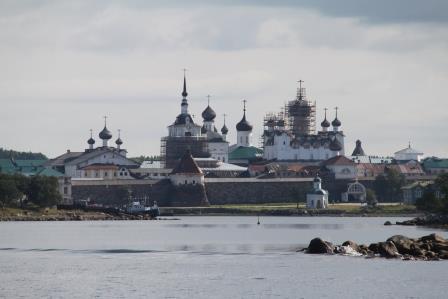[Part 3 of 14. Solovki 2013]
People have come to Solovki for thousands of years, but it wasn’t until the late 15th century that humans began to live full time on the island.
For centuries, fishers would take boats to the islands in the summer months to take advantage of the rich fishing in the waters nearby. When winter came they would return to their homes on the mainland with fish aplenty (one presumes) for the long, cold months ahead. These pre-historic fishers have left behind amazing stone constructions: labyrinths and burial mounds.
In 1429, the first two permanent settlers on the island were Orthodox monks—by the names of Savvatii and German. They sought out the islands not for the fish that had brought so many people before them, but for solitude and separation from other humans to be able to worship God more fully and without any of the distractions of humanity.
The Solovetskie islands were hardly an easy place to live, and Savvatii was an old man. But they sought the most distant place possible where they might live a life of asceticism. They searched for a place where they could pray and work without interruption, and where the forces of nature and the cold climate would test their spirits and their bodies each day.
The very distance and seclusion of Solovki—and its environment, forests, and fish—made it a compelling choice for these two men; a place where their travails and sufferings and prayers would allow them to become more like angels than men.
And while I stood comfortably on the ferry as it plowed the waters to Solovki, I couldn’t stop thinking that these two men so many centuries before had rowed out across the sea to an island they had never seen before to start a life as distant from other people and as physically grueling as possible. My own journey was a piece of cake in comparison.
The historian Roy Robson who has written a marvelous book on Solovki asks, “What would make someone leave life behind, seeking an existence of unremitting toil and prayer, where sleep and food were considered weaknesses of the flesh.” What indeed?
In one of the great paradoxes, word spread quickly of the holiness of these two men and soon others wished to join them or live nearby, to learn from them and their ascetic life. And so began one of the great struggles of the religious community on Solovki: whether to search for complete isolation so better to pray and to live a godly life of renunciation or to share and spread the asceticism and to build a larger religious community.
As the years and decades passed, the monks on Solovki struggled with the question over how best to serve God. In the end, it was the latter view that won the day. And one of the most glorious monasteries exists now as a result.
Over time, the number of monks on the island grew, and so too did the number, size, and quality of buildings that made up the monastery. In the 16th and 17th centuries, the monastery expanded widely and rapidly. It attracted more and more monks, and more and more pilgrims. There were ups and downs to be sure (especially during the great Russian religious Schism of the 17th century, when the monastery was at war with the Orthodox Church). But, the monastery grew, built massive walls, and became one of the most economically successful ventures in the region.
Two of the participants in our group, Julia Lajus and Aleksey Kraikovsky, are specialists on the history of the sustainable and immensely profitable fishing industry that developed on the island.
The result was one of the most impressive monastery complexes in the Orthodox world, with impressive churches and daunting, massive walls and turrets. [Just look at the thickness of the walls of the monastery in the photos below]
The monastery has served a spiritual center for generations. It played a small but noteworthy role in the Crimean War when British ships fired on the monastery hundreds of times and miraculously caused no damage.
And then in the 1920s and 1930s, the monastery became the stage for one of the darkest stories of the 20th century: the GULAG–the Soviet prison system. More on the Gulag in a later post.
Before 1990, Solovki housed parts of the Northern Naval Fleet.
Now a monastery again, it has been a World Heritage Site since 1992.
Those interested in more on the Solovetskie islands, should read Roy Robson’s excellent history: Solovki: The Story of Russia told through its Most Remarkable Islands (New Haven and London: Yale University Press, 2004).

Solovetskii Monastery. Massive stone walls, built initially stone on stone without any bonding between them. A beautiful rearranging of nature for human needs





